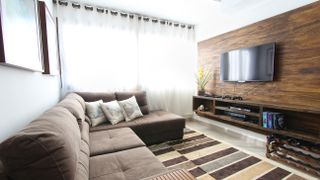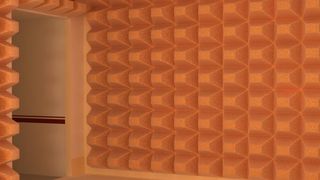There are several reasons you might be wondering how to soundproof a room on a budget. The most common of which is so that you can record live musical instruments and vocals without disturbing anyone in your home or your neighbors. And it works the other way too, as a properly soundproofed room stops outside noise from bleeding in during recording.
Other people may choose to opt for a fully soundproofed room so that they can simply listen to the music they love at very loud volumes, as opposed to listening on the best headphones. Others still may think about soundproofing for their home cinema, filling the space with the best TVs and soundbars too.
Also, when we say 'soundproofing', we mean sound reduction. That's because not even professional soundproofers can guarantee to 100% soundproof a room - vibrations always find their way in. To soundproof a room as much as possible, as you'd find in professional recording studios, you'd have to create 'dead air' so that no sound enters or exist. This can be achieved by hanging suspended ceilings and floating floors, which is very costly and over the top for most peoples' sound reduction needs.
So, assuming that you aren't looking to build a fully soundproofed professional recording studio, and that you are instead wondering how to soundproof a room on a budget, we have some practical tips for you right here. Let's get started...
How to soundproof a room on a budget: Items to use
Foam is a common material used to soundproof a room, and you can buy read-made kits containing the correct amount pf foam for the size of the room you're soundproofing. However, these kits can be expensive and aren't as easy to take down or pack away as the items listed below. This is something to keep in mind if the room you want to soundproof is part of a rented property.
Working out exactly how sound is traveling into your room is vital to blocking it effectively. Common places for sound leaks usually include poorly sealed windows and doors, and thin stud walls.
Some of the more cheaper materials you can use to soundproof a room, and that are easy to take down and pack away if you need to move, include:
- Absorption pads on walls and floors
- Thick acoustic blankets
- Thick carpeting
- Thick rugs scattered around the room
- Heavy, lined drapes on top of blinds

How to soundproof a room on a budget: Top tips
Seal doors and windows
One of the first tips to soundproofing a room is to ensure that doors are properly and totally sealed, as sound can slip through the crevices beneath doorways. Installing a door sweep is relatively cheap and easy to do, and will stop sound from escaping and intruding from underneath the door.
For crevices around light fixtures or windows, acoustic sealant traps sound from escaping. Thick blinds and heavy drapes over the windows also help sound from escaping.
Lay thick carpet or rugs
Flooring is an important factor in sound travel. A hardwood or concrete floor induces sound travel and echo, so having thick carpet on the floor reduces the amount that sound bounces around in a room. Since it can be expensive to carpet an entire room, placing thick rugs on the floor also helps reduce sound travel.
Hang blankets on the walls
There are a handful of ways to prepare the walls in a room to dampen sound. One of the cheapest ways is to hang thick blankets or tapestries along your walls. Acoustic blankets are more specialist and something you'll see more of in recording studios.
If you have a preference about the room's appearance, try to hang aesthetically pleasing quilts or blankets to keep the room from becoming an eyesore. Have an old mattress hanging around? You could could stand it against one of the walls to dampen sound. This works well but it's a very unattractive solution.
Glue egg cartons to the walls
Cardboard egg cartons are a very basic, DIY version of sound-reflecting material, but filling an entire room with egg cartons is both time-consuming and, well, it doesn't work for sound reduction. How come? Due to their peculiar shape, egg boxes reduce sound echo in a room, and therefore lend themselves well to home cinemas.
Staggered placement of a handful of them at a time, grouped together into small batches, will deflect sound waves off into different directions instead of bouncing back in the same place.


